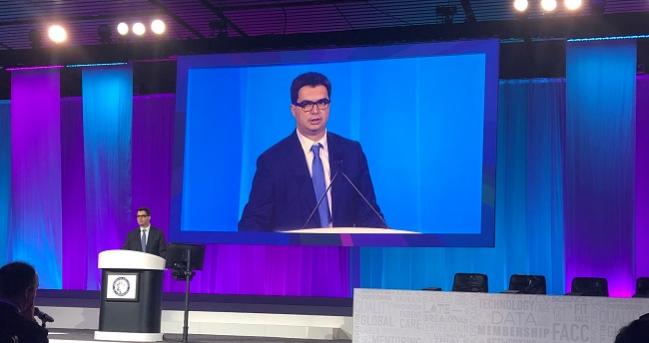No TREAT for Ticagrelor at 12 Months: Fibrinolysis Patients After STEMI Do Just as Well on Clopidogrel
Extended follow-up shows “neutral” results for the two P2Y12 inhibitors in STEMI patients initially treated with fibrinolytic therapy.

NEW ORLEANS, LA—Twelve-months of ticagrelor among older STEMI patients first treated with fibrinolytics offers no benefit over 12 months of clopidogrel, extended results from the TREAT trial show. Cardiovascular event rates were similar between groups, and no differences were seen in rates of major bleeding.
Earlier results from the TREAT trial, as reported by TCTMD last year, provided reassurance to physicians unsure whether patients initially managed with a lytic could be treated with the more potent ticagrelor. The large, randomized PLATO trial excluded patients treated with fibrinolytics, while the CLARITY and COMMIT trials that established the safety of clopidogrel following lytics are now a decade and a half old.
But the TREAT extended results, presented here at the American College of Cardiology 2019 Scientific Session, failed to show what some, no doubt, were hoping for: namely, that continued ticagrelor would beat out clopidogrel in this group.
Otavio Berwanger, MD (São Paulo Cardiac Hospital, Brazil), who presented the data, characterized the findings as unresolved. “We could discuss whether this is a definitive result or underpowered,” he said. At least in TREAT, he said, for patients aged under 75 years with ST-segment elevation myocardial infarction, administration of ticagrelor after fibrinolytic therapy may not reduce the frequency of major cardiovascular events at 12 months when compared with clopidogrel.
The 12-month results were simultaneously published in the Journal of the American College of Cardiology.
Extended TREAT
TREAT was conducted in 10 countries worldwide including a mix of developed and developing nations. Investigators enrolled 3,799 patients under the age of 75 and treated with fibrinolysis. They were then randomized to 180 mg ticagrelor (Brilinta; AstraZeneca) as early as possible after the index event (within 24 hours) then followed by 90 mg twice daily for 12 months, or to 300 mg of clopidogrel as early as possible followed by 75 mg/day for 12 months. Fibrinolysis was typically initiated within a mean of 2.6 hours in both groups, while study-drug randomization typically occurred within 11.5 hours of fibrinolysis.
At 12 months, there were no significant differences in TIMI major bleeding, PLATO major bleeding, or BARC type 3-5 bleeding. Differences did, however, emerge for other bleeding definitions including TIMI minimal, TIMI clinically significant, and total bleeding.
For the combined endpoint of CV death, MI, stroke, severe recurrent ischemia, TIA, or other arterial thrombotic events, no differences were seen between clopidogrel and ticagrelor at 12 months.
Interpreting the Results
“This is a definitive neutral study but there’s room for uncertainty here,” Berwanger said in a press conference following his presentation. “In my hospital we use ticagrelor mainly, but when we have a patient postlytic, everyone says, ‘oh, well, now we need to use clopidogrel,’ so at least it’s reassuring that it’s safe and [the composite CV event rate] goes in the same direction as PLATO. I’m not conveying that we should switch everyone to ticagrelor, but at least we have another option. It may be useful in some circumstances, but people have to use their judgement, the evidence, patient preferences, cost, and other issues.
During the press conference, discussant Claire Duvernoy, MD (VA Ann Arbor Healthcare System, MI), said that her takeaway from these 12-month results is “a little bit different” than Berwanger’s.
Clearly my hospital administrator wouldn’t thank me if I said I was going to start using ticagrelor in everybody. Claire Duvernoy
“Mine is, it doesn’t matter so much whether you give ticagrelor or clopidogrel, so maybe clopidogrel is the better way to go after fibrinolytics,” she said. “What we saw earlier in PLATO was that it is more important to use ticagrelor when you are doing PCI in a STEMI. And for fibrinolytic therapy, I agree that it’s very important to have gotten that safety signal that yes, it’s safe to give ticagrelor or clopidogrel early. But as far as it being okay using clopidogrel, I think that would be the important message that I took away from your trial.”
Ticagrelor is the more expensive drug. If both are options, Duvernoy quipped, “clearly my hospital administrator wouldn’t thank me if I said I was going to start using ticagrelor in everybody.”
Roxana Mehran, MD (Icahn School of Medicine at Mount Sinai, New York, NY), who chaired the media briefing, expressed surprise that PCI is still so underused following initial fibrinolysis, even in developed countries.
Berwanger agreed, noting that “there’s a lot of regional differences.” While a pharmacoinvasive strategy is used in countries like Australia and Canada in 70-80% of patients, in Latin America, China, and Russia, that’s closer to 40%, he said.
“Even in the United States, there is wide regional variability,” Duvernoy chimed in, noting that lytics are still widely used in Alaska, “because they just can’t get patients to PCI centers.”
Shelley Wood was the Editor-in-Chief of TCTMD and the Editorial Director at the Cardiovascular Research Foundation (CRF) from October 2015…
Read Full BioSources
Berwanger O, Lopes RD, Moia DDF, et al. Ticagrelor versus clopidogrel in patients with STEMI treated with fibrinolytic therapy: TREAT Trial. J Am Coll Cardiol. 2019;Epub ahead of print.
Disclosures
- Berwanger reports grants and personal fees from Astra Zeneca, grants from Amgen, grants and personal fees from Bayer, personal fees from Novo Nordisk, grants from Boehringer Ingelheim, grants and personal fees from Roche Diagnosis, personal fees from Sanofi, outside the submitted work.


Comments